Caladiums are valued in landscapes and containers for their colorful and variable-shaped leaves. Two types of caladium cultivars exist in commercial production: fancy- and lance-leaved. 'Florida Sweetheart' is the most popular lance-leaved commercial cultivar of all colors. It produces wide lance leaves with a rosy color and relatively large tubers. 'Florida Red Ruffles' is the most popular red, lance-leaved commercial cultivar among caladium growers, greenhouse growers, and nurseries. It has excellent sunburn tolerance. Both cultivars were introduced by the University of Florida (UF) caladium breeding program.
'Fairytale Princess' and 'Red Hot,' two vibrant red, lance-leaved cultivars from UF, have novel combinations of plant and foliar characteristics. 'Fairytale Princess' leaves are heart-shaped like those of 'Florida Sweetheart' but have a large red center and numerous netted red veins. 'Fairytale Princess' plants are taller and produce longer and wider leaves than 'Florida Sweetheart' plants. 'Red Hot' leaves are cordate-lanceolate like 'Florida Red Ruffles' leaves but have a large, glossy, red center and numerous red, thick veins. 'Fairytale Princess' and 'Red Hot' were comparable or superior in replicated field, greenhouse, and landscape trials to 'Florida Red Ruffles' and 'Florida Sweetheart' in tuber yield, pot plant quality, and landscape performance. 'Fairytale Princess' and 'Red Hot' are suitable for producing pot plants. Tuber de-eyeing is not required for forcing in small containers. These characteristics should make 'Fairytale Princess' and 'Red Hot' economically viable and profitable cultivars for commercial production of caladium tubers. The availability of 'Fairytale Princess' and 'Red Hot' can help expand the caladium plant palette for greenhouse growers, nurseries, and gardeners.
Description
Description of colors for plant parts is based on comparison with the Royal Horticultural Society Color Chart. Three plants used for describing colors were grown in 8-inch containers in a 30% shaded greenhouse from No. 1 (1½ to 2½ inches in diameter) de-eyed tubers.
'Fairytale Princess': Plants of this cultivar grown in the Fafard 3B potting mix (Conrad Fafard, Inc.) under shade for approximately 2 months (Figure 1) have an average height of 16 inches and produce 35 to 47 leaves per plant. Large leaves have an average size of approximately 8.5 inches long and 5.7 inches wide. Leaves are ovate and have a cordate or heart-shaped base, an acuminate to acute apex, an entire and slightly undulate margin, and two relatively large basal lobes. On the upper leaf surface, a green margin borders the entire leaf except for the basal leaf valley, where it is grayed-purple. The leaf center is red. Venation pattern is pinnate, with as many as 16 grayed-purple veins radiating from a central main vein of red and connecting marginally with a thin grayed-purple vein that parallels the leaf margin. Secondary and tertiary veins tend to be netted across the entire leaf. Small blotches of green and/or numerous specks of white may appear along the margins and between primary veins. Occasionally red speckles may appear between the primary veins. The leaf undersurface has a greyed-green margin, a greyed-purple center, a greyed-red midrib vein, and several grayed-green primary veins. Irregular grayed-yellow and grayed-green mottling parallels the margin. Petioles are mostly erect, curving outwardly with development, grayed-red at the apex, but the colors diffuse into black at the base. In addition to numerous short brown to dark streaks, a few long brown to dark streaks may extend from the apex to the base of the petiole. Jumbo tubers are multisegmented, bearing six to nine dominant buds. Tuber surfaces are brown, with the cortical area yellow-orange.
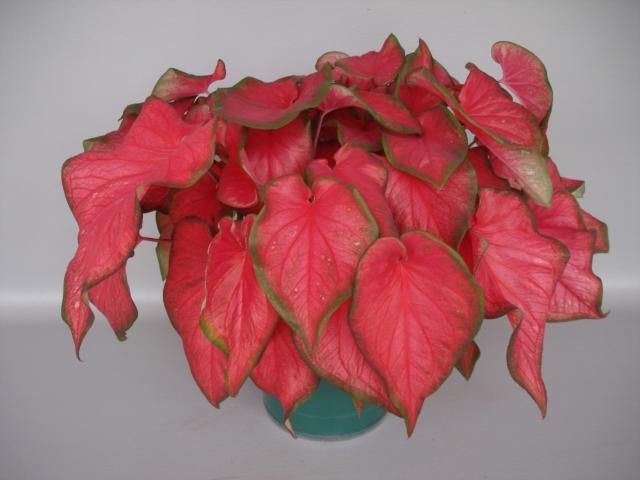
Credit: Gail Bowman (UF/IFAS GCREC)
'Red Hot': Plants of this cultivar grown in the Fafard 3B potting mix and under shade for approximately 2 months (Figure 2) have an average height of 16.5 inches and produce 40 to 55 leaves, up to an average of 8.5 inches long and 5.3 inches wide. Leaves are ovate and have a sagittate or arrowhead-shaped base, an acuminate to acute apex, an entire and wavy margin, and two obvious basal lobes. On the upper leaf surface, a broad green margin borders the entire leaf except for the basal leaf valley, where it is grayed-purple. The leaf center is red and can be highly glossy. As many as 16 large, red veins radiate from a central main vein of red and connect marginally with a thin grayed-purple vein that parallels the leaf margin. Irregular green mottling parallels the margin. The leaf undersurface has a grayed-green margin, a grayed-purple center, and grayed-red veins. The center and veins are covered with grayed-white wax. Irregular grayed-green mottling parallels the margin. Petioles are grayed-red at the apex, and the colors diffuse into a light grayed-purple at the base. The upper portion of the petiole below the apex is frequently covered with a grayed-white wax. Numerous short brown speckles are present on the petioles. Jumbo tubers are multisegmented, bearing six to nine dominant buds. Tuber surfaces are brown with the cortical area yellow.
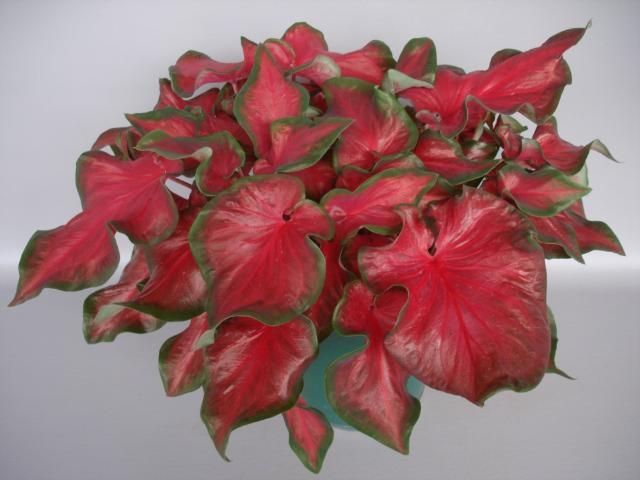
Credit: Gail Bowman (UF/IFAS GCREC)
Tuber Yield Potential
Field trials: 'Fairytale Princess' and 'Red Hot' were evaluated for tuber production at the UF/IFAS Gulf Coast Research and Education Center in Wimauma, FL, in 2007, 2009, and 2010. The soil was EauGallie fine sand with about 1% organic matter and a pH value between 6.2 and 7.4. Caladium plants were grown in the field using a plastic-mulched raised-bed system. In 2007, ground beds (32 inches wide, 8 inches high) were fumigated on April 3 with a mixture of 67% methyl bromide and 33% chloropicrin (by volume) at the rate of 175 pounds per acre. Caladium seed pieces (tuber pieces, approximately 1 inch × 1 inch × 1 inch) were planted on April 26. Fertigation (through the drip irrigation system) began when young caladium plants emerged from the soil, supplying 6N-0.8P-3.9K soluble fertilizer at the rate of approximately 1.7 pounds of nitrogen per acre per day and a total of 260 pounds of nitrogen per acre per growing season. Tubers (new crop) were dug, washed, and dried in early January 2008. In 2009, field beds were fumigated on February 27 with a mixture of 50% methyl bromide and 50% chloropicrin (by volume) at the rate of 175 pounds per acre. Caladium seed pieces were planted April 9. The irrigation and fertigation system was the same as the one used in 2007, but one teaspoon of the controlled-release fertilizer Osmocote® (15-9-12, 5–6 months) was applied to each plant on July 21. Tubers were dug on November 30 to December 2, 2009, followed by washing, drying, weighing, grading, and counting as done in 2007. In 2010, ground beds were fumigated on March 21 with PIC-Clor® 60 (39% 1,3-dichloropropene and 59.6% chloropicrin; Soil Chemicals Corp., Hollister, CA) at the rate of 380 pounds per acre. Caladium seed pieces were planted on April 9. A seepage irrigation system was used to maintain a water table below the caladium root system. Approximately 14 grams of Osmocote® (15-9-12, 8–9 months) were applied to each plant on May 18 and again on August 13. Caladium tubers were dug December 3–6. Tuber washing, drying, weighing, and grading were conducted as described above.
Field plots were arranged each season in a randomized complete block fashion with three blocks; each plot was 13 square feet and was planted with 30 caladium seed pieces. Two commercial cultivars, 'Florida Red Ruffles' and 'Florida Sweetheart,' were included as check cultivars or controls in each block.
'Fairytale Princess': This cultivar was more productive than 'Florida Sweetheart' in 2007 and was as productive as 'Florida Sweetheart' in 2009 and 2010 (Table 1). 'Fairytale Princess' produced more marketable tubers (75.0 vs. 45.7) and had a greater production index (148 vs. 105) than 'Florida Sweetheart' in 2007. 'Fairytale Princess' and 'Florida Sweetheart' produced similar amounts and similar marketable numbers of tubers and generated similar production indexes in 2009 and 2010. 'Fairytale Princess' and 'Florida Sweetheart' shared a similar tuber grade distribution. 'Fairytale Princess' was more productive than 'Florida Red Ruffles' in two of the three growing seasons. 'Fairytale Princess' produced more marketable tubers in 2007 (75.0 vs. 42.0) and 2009 (76.7 vs. 44.7) plus a higher production index in 2007 (148 vs. 85) and 2009 (146 vs. 72). However, 'Fairytale Princess' and 'Florida Red Ruffles' produced similar amounts and similar numbers of tubers in 2010. The majority (60% or more) of tubers produced by 'Fairytale Princess' were in the categories of No. 1, Jumbo, or Mammoth, similar to the size distribution of 'Florida Red Ruffles' (Table 1).
'Red Hot': This cultivar was as productive as 'Florida Sweetheart' in both 2009 and 2010 growing seasons (Table 1). The two cultivars produced similar amounts of tubers, similar numbers of marketable tubers, and similar production indices in 2009 and 2010. 'Red Hot' was more productive than 'Florida Red Ruffles' in 2009 and as productive as 'Florida Red Ruffles' in 2010. 'Red Hot' produced a greater amount of tubers (7.5 LB vs. 4.0 LB), a larger number of marketable tubers (61.0 vs. 44.7), and a higher production index (135 vs. 72) in 2009. 'Red Hot' and 'Florida Red Ruffles' produced similar amounts of tubers, similar numbers of marketable tubers, and a similar production index in 2010. 'Red Hot' and 'Fairytale Princess' produced similar tuber weights and generated similar production indices in 2009 and 2010, but 'Red Hot' produced fewer marketable tubers than 'Fairytale Princess' in 2009. The majority (70% or more) of tubers of 'Red Hot' were in the No. 1, Jumbo, and Mammoth grades (Table 1).
Container Trials
'Fairytale Princess': The suitability of 'Fairytale Princess' for pot plant production was evaluated by forcing tubers in 4½-inch containers in spring 2008. No. 1 tubers were planted in a peat/vermiculite mix on April 17, 2008. The study was conducted in a greenhouse with 45% light exclusion. Average daily temperatures in the greenhouse ranged from a low of 60°F night to 85°F day during the trials. Potted plants were arranged on metal benches in the greenhouse in a randomized complete block fashion with eight replicates. Plant height, plant width, number of leaves, and foliar characteristics were recorded on June 12, 2008, 8 weeks after planting. Quality of the potted caladium plants was rated on a scale of 1 to 5, with 1 = very poor, few leaves, totally unacceptable as potted plants; and 5 = very attractive with many bright, colorful leaves, a full plant, a symmetrical shape, and an appropriate height.
Intact tubers of 'Fairytale Princess' sprouted ~30 days after planting, approximately 5 days later than 'Florida Red Ruffles' and 'Florida Sweetheart' (Table 2). 'Fairytale Princess' plants were 1½ to 2½ inches taller and 6 to 7 inches wider than 'Florida Red Ruffles' and 'Florida Sweetheart' plants. 'Fairytale Princess,' 'Florida Red Ruffles,' and 'Florida Sweetheart' plants produced similar numbers of leaves (approximately 19), but again 'Fairytale Princess' leaves were about 1½ to 2 inches longer and ½ to 1 inch wider. Pot-grown 'Fairytale Princess' plants produced multiple bright red leaves and received significantly higher quality rating (3.8) than 'Florida Red Ruffles' and 'Florida Sweetheart' plants (2.7 to 2.9). Thus this cultivar does not require tuber de-eyeing to produce high-quality plants, even when forced in small containers.
'Red Hot': The suitability of this cultivar for pot plant production was evaluated in 4½-inch square containers in spring 2012. No. 1 tubers were planted either intact or de-eyed in Fafard 3B Mix (Conrad Fafard Inc.) on April 13, 2012. The greenhouse was covered with an aluminum shade cloth and had approximately 35% light exclusion. Average daily temperatures ranged from a low of 63°F night to 85°F day during the experiment. One teaspoon of Osmocote® controlled fertilizer (15-9-12, 5–6 months) was applied to each pot on May 13, 2012. Plant height, plant width, plant quality, number of leaves, and foliar characteristics were recorded on June 11, 2012, approximately 8 weeks after planting.
'Red Hot' produced high-quality pot plants regardless of tuber treatments (intact or de-eyed) (Table 2). When tubers were planted intact, 'Red Hot' tubers sprouted ~28 days after planting, approximately 6 to 8 days later than 'Florida Red Ruffles' and 'Florida Sweetheart'. Tuber de-eyeing did not cause any significant change in sprouting time in 'Red Hot.' 'Red Hot' plants, either intact or de-eyed, were likely to be 1 to 2 inches taller than 'Florida Red Ruffles' and 'Florida Sweetheart' plants but were similar in plant width (Figures 3 and 4). Intact or de-eyed 'Red Hot' plants produced similar numbers of leaves (28.8 to 36.0 per intact plant, and 42.4 to 57.3 per de-eyed plant) and had similar leaf lengths (6 to 7 inches on intact plants, and 5 to 6 inches on de-eyed plants) and leaf width (4½ to 5 inches on intact plants, and 3½ to 4 inches on de-eyed plants). Pot-grown 'Red Hot' plants produced a superb number of bright red, glossy, wavy leaves and received high quality ratings (3.8 to 3.9 for intact plants, and 4.2 to 4.8 for de-eyed plants) along with 'Florida Red Ruffles' and 'Florida Sweetheart.' These data indicate that 'Red Hot' tubers do not need de-eyeing to produce high-quality finished pot plants, but de-eyeing could further improve the plant quality (Figure 5).
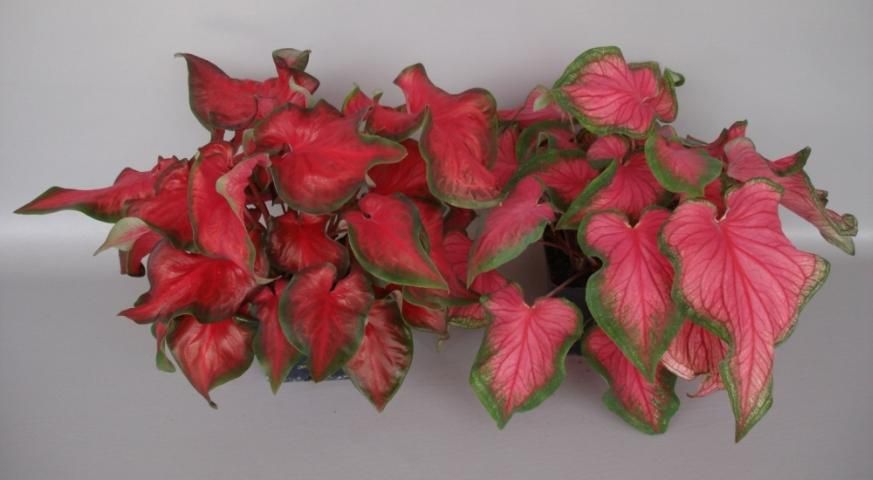
Credit: Gail Bowman (UF/IFAS GCREC)
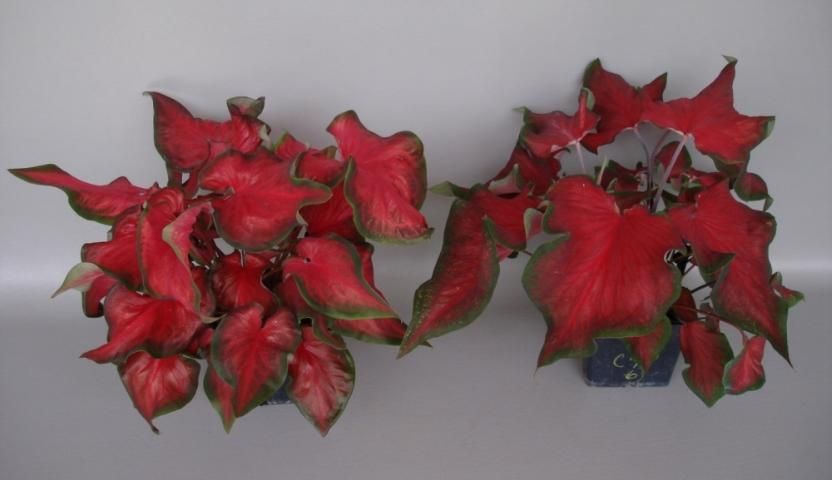
Credit: Gail Bowman (UF/IFAS GCREC)
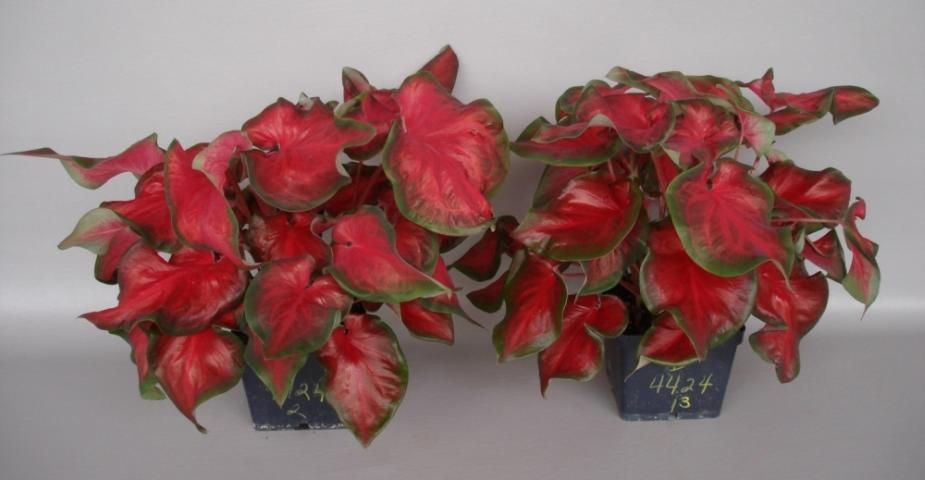
Credit: Gail Bowman (UF/IFAS GCREC)
Landscape Performance
Landscape performance of 'Fairytale Princess' and 'Red Hot' was evaluated on the same plots used for evaluating tuber production. A scale of 1 to 5 was used, with 1 being very poor (few leaves and lack of vigor) and 5 being excellent (full plants, numerous leaves, and bright color display). Also, leaf sun tolerance was evaluated on a scale of 1 to 5, with 1 being very susceptible to sunburn (leaves having numerous sun-damaged areas or holes) and 5 being resistant to sunburn (no visible sun-damaged areas). A total of eight evaluations were conducted for plant performance and sunburn tolerance over three growing seasons in 2007, 2009, and 2010. Approximately 4 months after planting, plant height, number of leaves, and leaf size were measured on three plants randomly chosen from each plot.
'Fairytale Princess': This cultivar exhibited excellent plant vigor and growth habit when grown in ground beds in full sun (Figure 6). Plants had an average height of 14 inches after growing in full sun and sandy soil for about 4 months, about 5 to 7 inches taller than 'Florida Red Ruffles' or 'Florida Sweetheart' plants (Table 3). Large leaves of 'Fairytale Princess' had an average size of 9.9 inches long and 6.3 inches wide, approximately 2 to 3 inches longer and approximately 1 to 2½ inches wider than 'Florida Red Ruffles' and 'Florida Sweetheart' leaves. 'Fairytale Princess' plants developed a superb number of large, wide lance leaves in bright red and received very high plant performance ratings (4.2 to 4.9) in all evaluations from the three growing seasons (Table 4). The performance ratings of 'Fairytale Princess' plants were significantly higher than those of 'Florida Red Ruffles' in all nine evaluations and significantly higher than those of 'Florida Sweetheart' in five out of nine evaluations. 'Fairytale Princess' plants maintained excellent performance throughout the growing season. Both 'Florida Red Ruffles' and 'Florida Sweetheart' are considered sunburn-tolerant cultivars. The sunburn tolerance rating of 'Florida Red Ruffles' and 'Florida Sweetheart' in 2007, 2009, and 2010 ranged from 3.5 to 5.0 and from 3.3 to 4.7, respectively. 'Fairytale Princess' sunburn tolerance ratings were between 3.8 and 4.9, similar to 'Florida Red Ruffles' or 'Florida Sweetheart's sunburn tolerance ratings in most of the evaluations.
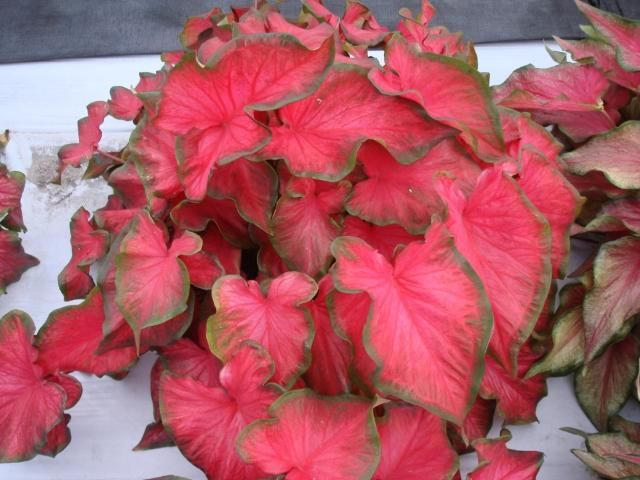
Credit: Zhanao Deng (UF/IFAS GCREC)
'Red Hot': This cultivar also exhibited excellent plant vigor and plant growth habit when grown in ground beds in full sun (Figures 7 and 8). Plants had an average height of 11.3 inches, approximately 3 inches shorter than 'Fairytale Princess' plants, and leaves were an average of 9.0 inches long and 5.2 inches wide, approximately 1 inch narrower than 'Fairytale Princess' leaves (Table 3). 'Red Hot' plants were about 3 inches taller than 'Florida Red Ruffles,' and their leaves were about 2½ inches longer and about 1¼ inches wider, but they produced a similar number of leaves. 'Red Hot' plants were also about 2 inches taller and leaves were about 1¼ inches longer than 'Florida Sweetheart.' 'Red Hot' plants received a sunburn tolerance score between 4.2 and 5.0, similar to 'Florida Red Ruffles' (4.2 to 5.0) in four out of five evaluations. 'Red Hot' sunburn tolerance scores were similar to 'Florida Sweetheart's (3.3 to 4.7) in 3 out of 5 evaluations, but better than 'Florida Sweetheart's in two evaluations (Table 4). These results demonstrate that 'Red Hot' possesses excellent sunburn tolerance for use in landscapes. 'Red Hot' plants grown in full sun produced a superb number of large, sunburn-tolerant, glossy, red leaves; they were full and very attractive and received performance ratings between 4.2 and 4.8, similar to 'Florida Sweetheart's performance ratings but significantly better than 'Florida Red Ruffles' ratings (Table 4).
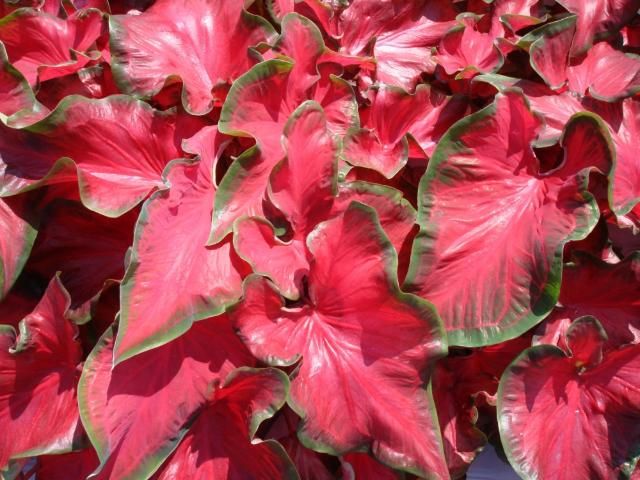
Credit: Zhanao Deng (UF/IFAS GCREC)
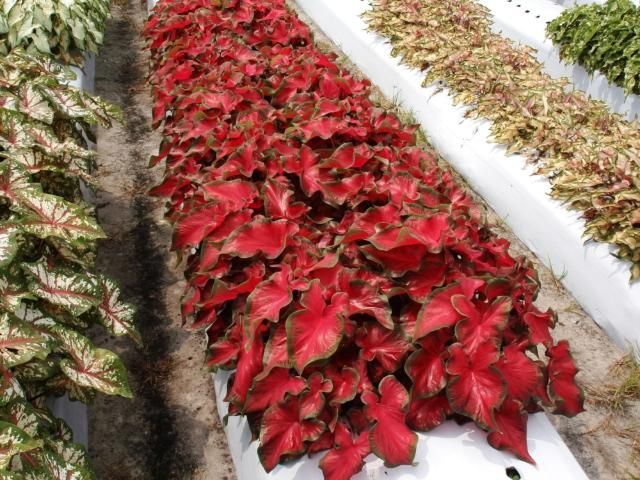
Credit: Zhanao Deng (UF/IFAS GCREC)
Recommendation
Plants of 'Fairytale Princess' produce a superb number of brightly colored, wide-lance to heart-shaped leaves like 'Florida Sweetheart,' but 'Fairytale Princess' leaves are novel with a bright red center and netted red secondary veins (Figures 9 and 10). 'Fairytale Princess' is like 'Florida Sweetheart' in canopy formation, cascading from the center to the side and producing an attractive, mounding plant in the landscape. 'Fairytale Princess' plants are tolerant of sunburn and can perform very well in both sunny and shady landscape locations. Similar to 'Florida Sweetheart', 'Fairytale Princess' produces high-quality potted plants, even in small containers (4½-inch diameter) and without de-eyeing of tubers. 'Fairytale Princess' is expected to be highly suitable for producing potted plants in a wide range of container sizes or for planting in the landscape. It should be noted that 'Fairytale Princess' produces larger plants and larger leaves than 'Florida Red Ruffles' and 'Florida Sweetheart', therefore larger spacing may be necessary for potted plant production. Also, 'Fairytale Princess' tubers sprout approximately 5 days later than 'Florida Sweetheart' tubers. Thus, one extra week may be needed to produce potted plants using 'Fairytale Princess' tubers. 'Fairytale Princess' is as productive as or more productive than 'Florida Sweetheart,' in terms of tuber yield potential.
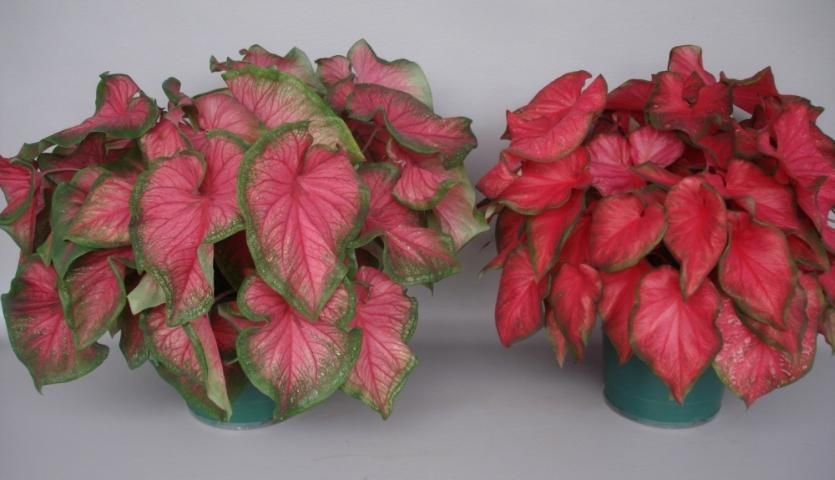
Credit: Gail Bowman (UF/IFAS GCREC)
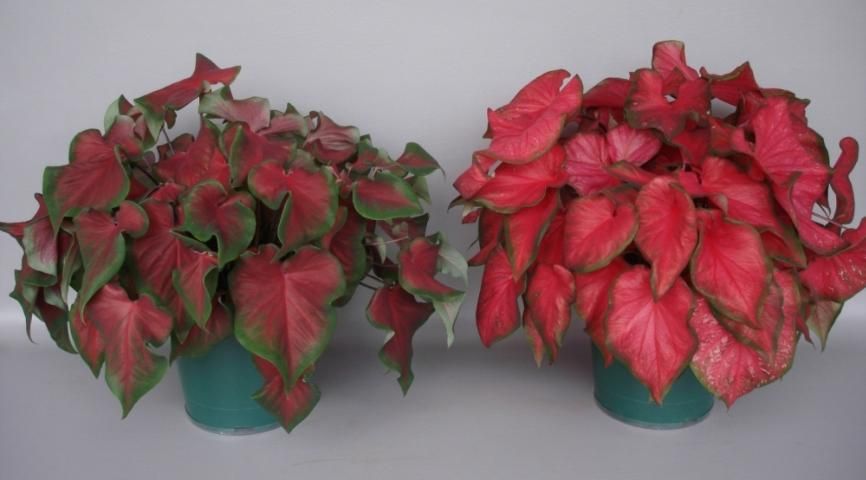
Credit: Gail Bowman (UF/IFAS GCREC)
The red lance-leaf group of caladium cultivars has been dominated by 'Florida Red Ruffles' over the last 10 years. 'Red Hot' produces large, brightly red, glossy, wide-lance leaves and is distinctly different from 'Florida Red Ruffles' (Figure 11) and 'Fairytale Princess.' 'Red Hot' tolerates sunburn very well and has demonstrated excellent performance in sunny landscapes. 'Red Hot' is more vigorous than 'Florida Red Ruffles' and produces taller plants with longer and wider leaves when grown in ground beds. This new cultivar can produce high-quality potted plants in small containers without tuber de-eyeing. During potted plant production, one extra week will be needed for 'Red Hot' as its tubers sprout 5 to 7 days later than tubers of 'Florida Red Ruffles'. Potted 'Red Hot' plants are taller (1 to 3 inches) than 'Florida Red Ruffles' plants. 'Red Hot' is as productive as or more productive than 'Florida Red Ruffles' in tuber yield. Therefore, 'Red Hot' is expected to become a highly desirable new cultivar that can be of significant value to expand the market for the red lance-leaved caladium cultivars.
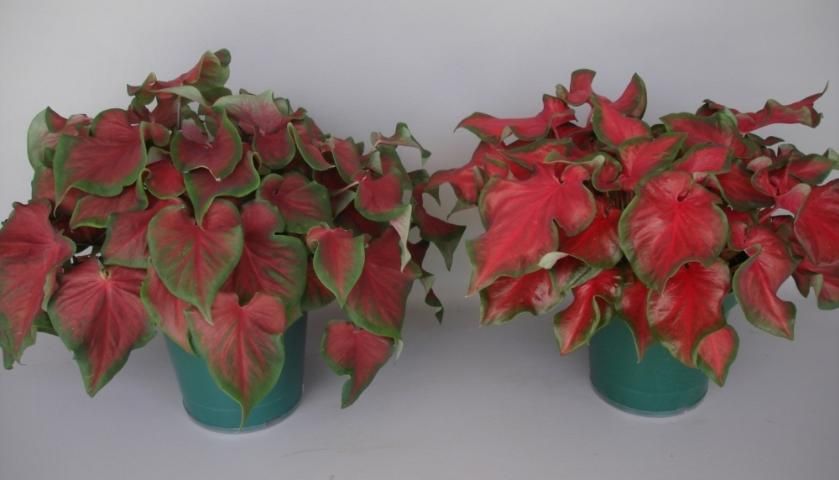
Credit: Gail Bowman (UF/IFAS GCREC)
Although 'Fairytale Princess' and 'Red Hot' share similarities in leaf type and color, significant differences exist in multiple aspects: 1) 'Fairytale Princess' leaves are heart-shaped while 'Red Hot' leaves are lanceolate with an elongated acute apex; 2) 'Red Hot' leaf margins are highly undulate while 'Fairytale Princess' leaf margins are only slightly undulate; 3) 'Fairytale Princess' leaves have netted gray-purple secondary veins while 'Red Hot' leaves lack noticeable netted veins; and 4) 'Red Hot' leaves are highly waxy and glossy while 'Fairytale Princess' leaves are not. 'Fairytale Princess' seems to be more productive than 'Red Hot' in tuber yield potential, and 'Red Hot' seems to be more tolerant of sunburn.
Although extensive research and evaluations of these cultivars have been performed on small acreages, growers are encouraged to plant only limited quantities of 'Fairytale Princess' and 'Red Hot' until they have gained experience in producing these cultivars. Standard postharvest treatment of tubers is recommended (Harbaugh and Tjia 1985) and pre-plant hot-water treatment of tubers (Rhodes 1964) is encouraged.
Availability
The Florida Agricultural Experiment Station has been issued plant patents for 'Fairytale Princess' (PP25,612 under 'UF 4412') and 'Red Hot' (PP25,598 under 'UF 4424'). Propagation and production of these cultivars are to be with a licensing agreement with the Florida Foundation Seed Producers, Inc., PO Box 309, Greenwood, FL 32443. Information on tuber availability and propagation agreements can be obtained from the Florida Foundation Seed Producers, Inc. (http://www.ffsp.net/varieties/caladium/).
References
Deng, Z., B.K. Harbaugh, and N.A. Peres. 2013. "UF 4412 and UF 4424 — Red lance-leaved caladium cultivars." HortScience 48(2): 239–244.
Harbaugh, B.K., and B.O. Tjia. 1985. Commercial forcing of caladiums. Circular 621. Gainesville: University of Florida Institute of Food and Agricultural Sciences.
Rhodes, H.L. 1964. "Effect of hot water treatment of seed tubers and soil fumigation for control of root knot on yield of caladiums." Plant Disease Reporter 8:568–571.
Royal Horticultural Society. 1986. RHS Colour Chart. Royal Hort. Soc., London.
Tables
Tuber weight, production index, and grade distribution of 'Fairytale Princess', 'Red Hot,' and two commercial cultivars grown in Wimauma, FL, in 2007, 2009, and 2010.
Plant characteristics and performance of 'Fairytale Princess,' 'Red Hot,' and two commercial cultivars grown in 4½-inch containers in a 45% shaded glasshouse in Wimauma, FL, in 2008 and 2012.
Plant characteristics of 'Fairytale Princess', 'Red Hot,' and two commercial cultivars approximately 4 months from planting tuber propagules (approximately 1 × 1 × 1 inch) in full sun and ground beds (sandy soil) in Wimauma, FL, in 2007, 2009, and 2010.